#hes a koi/marbled betta <3
Text

NAME SUGGESTIONS PLS
#HE IS BABY BOY!!!!!!#I LOVE HIM SO MUCH OMG#SO CUTE#look at my lil betta#also sorry for the grainy pic i gotta keep him in the dark until hes adjusted from the trip#so so pretty i love him#hes a koi/marbled betta <3
10 notes
·
View notes
Text
What’s wrong with bettas?
Annnd as promised, here’s that write-up on betta genetics and what’s wrong with all those pretty genes. We’ve got pictures and everything. This is a full, comprehensive list of the various problems with domestic betta traits. If you’re in the market for a new angry pal, then there’s a list of “good” things to look for in a betta at the end.
Just a quick intro before we begin: I’ve been into fishkeeping for over a decade, I currently have 16 running tanks ranging from 5 to 440 gallons, I’ve got about 200 fish at the moment, and I’ve had a good 20 to 25 bettas of my own over the years. When I was younger, I even bred a pair of pet store veiltails together, and reared some of the fry into adulthood. So, this is information coming from someone has both seen these things firsthand and talked with many, many other betta keepers who have done the same.
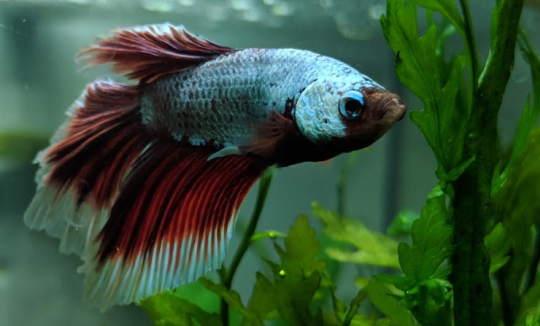
This is my new betta, Embezzlement. He looks great, right? He really does! But he’s also quickly going blind as a result of his thickened scales growing over his eyes, his fins will end up dragging him down to the point of immobility as he ages, and he’s at high-risk for developing visible tumors all over his body. I’ll get into that under the cut!
(To learn more about why the heck I willingly bought Bezel, just click the link attached to his name up there.)
((I don’t own any of these photos, or bettas, unless noted))
The Dragonscale Gene

We’ve all seen these boys and admired them. Please refer to my totally pro image mashup above and look at the thickened, shiny scales. That’s dragonscaling. It comes in white, grey, blue, and teal; and it can cover any part of the body, including the fins. Some have masks of dragonscaling, some have full body coats, and some just have intermittent patches. Most dragonscale bettas start developing noticeable dragonscaling at 1-2 months, and it continues spreading from that point on.

Now, if it was just a pretty shimmery gene, that would be great! But it isn’t. Dragonscales are abnormally thick scales that spread everywhere, even over their eyes. You can see the scales start to circle around the cornea on the left, and a progression on the three fish to the right. Once the scales reach the eyes, it’s only a matter of time before they go completely blind. (This is basically a guarantee for bettas with dragonscaling on their face.) If you don’t want a blind betta that can’t safely navigate its environment, stay away from those opaque, shiny, thick scales.
The Marble Gene
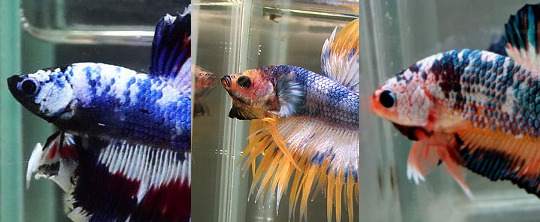
If you’ve ever seen a pretty “koi” betta covered in colorful blotches? That’s a marble. A weird, flesh-toned betta with neat speckles? That’s a marble. If you’ve ever seen a betta that’s changed colors over the span of its life? That’s 100%, definitely, without a doubt, a marble. The prevalence of marbles in the market is for 3 reasons: 1) it’s considered a dominant gene, 2) marbles are pretty rainbow boys, and 3) it’s also really, really hard to breed back out of lines.
So, the thing about marbles is... their pigment cells are constantly mutating. They can completely change colors in a couple months. Your red and black and white koi that you paid $30 for might turn into a muddy maroon right before your eyes. And since their cells are constantly mutating, you guessed it—

They’re prone to developing tumors. Yeah. They go lumpy even faster than the average betta.
Blue Bettas and Graphite Disease
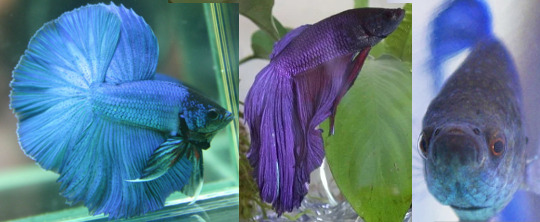
Nah, not even the comparatively boring bettas are safe. Bettas that are 90-100% blue with little other coloration on their bodies? They’re prone to graphite disease, which is a fast-acting killer with no known cure.

Their fins and bodies start turning grey, like someone shaded them with a pencil, and then boom: they’re dead within a few days. This is likely due to their reduced ability to process carotenoids, which are the substances responsible for increased red pigment. They also play an important role in keeping the immune system functioning properly, so without those.... yeah. They get sick even more easily than your average betta, and they die even more easily than your average betta. Also. Graphite disease. Not a fun time.
Red Bettas and Tumors
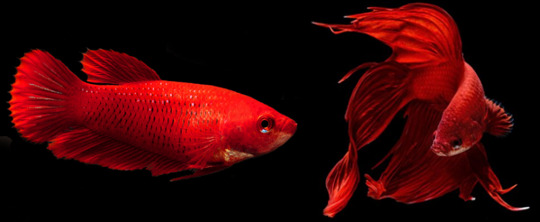
Pure red bettas are some of my favorites. Red is a symbol of good luck in Southeast Asia, where bettas are primarily bred and shown, so they’re also an important part of the industry. However, to get that pure, solid red coloration in a fish that’s descended from these guys:

You’ve got a lot of inbreeding to do. Linebreeding, inbreeding, crossing back, whatever you want to call it. It can be beneficial to show lines if you’re doing it right, because breeding the offspring of an animal back to its parent intensifies all of the traits that were passed onto it. However, with fish that are and have always been treated as trinkets, no one bothers screening for the negative traits that are being compounded along with the coloring.
So, red bettas are a whole mess of health issues, but they’re very prone to developing tumors. This is, unfortunately, one of the ones I have plenty of experience with. When I was younger, I had a male veiltail with solid red coloring, and he turned into a mass of lumps before dying. The same thing happened with my most recent betta, Genie. She was in my care for all of 9 months before I had to put her down, as there were multiple little tumors developing all over her body, and a large one over her internal organs that was visible from the outside.

Here’s a side by side comparison. From the day I got her to the day I euthanized her so she wasn’t in pain. For those of you who don’t know about her, she was the pond betta who lived in a 440 gallon blackwater biotope and fed a live insect-based diet. The pH in there is 5.8, the temp is 78F, the water quality is always 0/0/0, and there weren’t any environmental stressors that contributed to her decline in health. She was kept in the best conditions I could possibly give her, and she still went that far downhill in 9 months. She wasn’t a full year old.
Unfortunately, it gets worse from here! Get a glass of water, grab some snacks, we still have fin types to cover.
Halfmoons and Rosetails
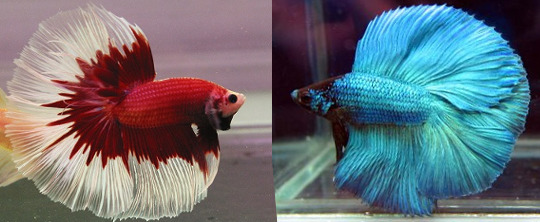
You see those two gorgeous guys above? Those are halfmoon bettas, one of the most popular and commonly available types of bettas! Note how dang big those fins are. They only have them fully extended like that when they’re flaring. Now, look at this picture of a halfmoon with his fins in the normal position:

See how they collapse into a long, ruffled shape? Two things here. 1) Those fins are literally useless and hinder them from swimming properly, so they have to exert way more effort than necessary to even move around. This is how we get that signature “betta wiggle” that people find endearing. To properly drag those massive fins around and keep them from dragging, they have to undulate their whole body in an exaggerated manner, which gets harder and harder as they age.
And 2) This leads to fin biting. Note how that poor guy’s tail is all tattered and shorter than his ventral and dorsal fins. When bettas are weighed down by their own fins? Their solution is, a lot of the time, to self-mutilate and nip them off. The jury is still out on whether or not they have feeling in their fins; but even if they don’t, they’re still opening themselves up to potential infections. Plus.... even the fish don’t want those draperies. C’mon. You know it’s not good if they’re literally tearing themselves to shreds just so they can swim again.
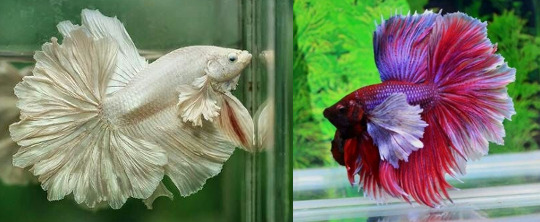
Can’t forget rosetails, either! That blind pal on the left and living tulle skirt on the right are bred for fins that go over the halfmoon point (they aren’t a semi-circle, they’re more like a pizza with a couple slices taken out) and have enough bulk that they stay ruffled even when they’re flaring. For obvious reasons, these are even worse than halfmoons. Oh god those poor fish.
Crowntails
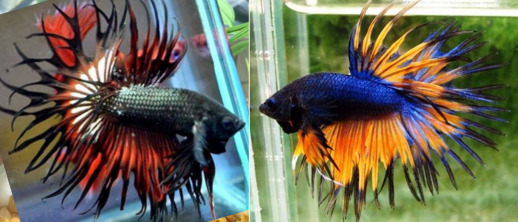
These spiky boys are crowntails, another common fin type seen in Petsmarts and Walmarts everywhere. Not much to say about them that wasn’t covered under the halfmoon section. They’re fin biters, because even though they don’t have as much fin mass, those tendrils still create large amounts of drag and hinder their movement.
Doubletails

We took a halfmoon and we made it worse. That.... that takes skill. These genetic abominations were specifically bred to have not one, but two tails! And I’m not sure how much truth there is behind this, but their spine is supposed to split into two portions to create that Y shaped tail. Obviously, that would strain their spine and create a whole handful of new problems, on top of that further decreased swimming ability. (After Bezel passes, I’ll probably get a doubletail and see if that spine thing checks out.)
Congrats! You made it to the bottom!
Now, here’s what to look for, if you want to buy a healthy(er) betta.
If you’ve been in a pet store recently and looked at the shelf with all the bettas on it, you can probably recognize some of these traits in 9/10 fish. And if they’re not lying on their side on the edge of death, they’ll probably look good and healthy and tempting to take home.
Remember how screwed up those bettas are, though, and get one of the better options. Here’s a list of questions to ask yourself before taking a betta home.
Male or female? When it comes to fin types, females will almost always be better off than males. Thanks to sexual dimorphism, female bettas have shorter, less exaggerated fins. Therefore, a crowntail female can swim about as easily as a plakat (read: short-finned fighter type) or veiltail betta. If it’s a female, just make sure the fins aren’t bitten or weirdly long. If it’s a male, see below.
How drastic are the fins? The shorter, the better. Just make sure they aren’t short because they’ve bitten them off. Also, veiltails are one of the healthiest fin types currently available, because they’re an “undesired” trait, and have wider gene pools as a result of not being inbred to a severe degree. They're functional, too! These boys can swim.

How pretty is it? If the betta looks like a galaxy painting threw up on it, then chances are, it’s gonna have some issues later in life. You want a betta that’ll hopefully live for years? Get an ugly one. Orange, yellow, tan, peach, dirty white, whatever. Stay away from those solid reds/whites/blacks/blues. Those two boys above are great examples of “ugly” bettas. Even though the one on the left is marble, he still has a better chance of living a good life than an inbred solid black disaster.

If you want something a little fancier than a fish that looks like.... well, kind of like flesh, get a cambodian! Their coloration is a variation of piebald. They’re characterized by a light, peachy body and colorful fins. They’re pretty flesh fish. These were actually one of the earliest types of domestic bettas, fun fact.
How shiny is it? Shiny scales don’t automatically mean they betta is a dragonscale carrier. For example, compare these crowntail and plakat (that fighter-type mentioned above) males to the true dragonscales at the very top. Lightly shimmery scales that naturally fade into the body aren’t dragonscales. If they’re the same size and thickness as the rest of the scales, they probably aren’t dragonscales. You can get an eye for telling the two apart after awhile.
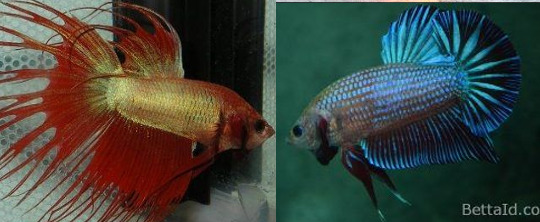
And that’s it, that’s the show. Thanks for reading!
This guide was written on 2/03/2019 and will be edited as necessary.
2/08/2019: edited to remove swearing
#long post#bettablr#fishblr#aquablr#this took so damn long oh my god#but it's done! and it should be useful!#crowntail#halfmoon betta#rosetail betta#dragonscale#veiltail betta#betta tag
6K notes
·
View notes
Text
In case anyone’s wondering, I’m still here and chugging along. I haven’t been posting so many pictures mostly because the Betta albimarginata spawns have been getting more of my attention these days. Also, admittedly, Animal Crossing, lol.
But here are some updates if anyone’s interested:
Nimbus, the black crowntail, is still as spunky as always, even if he rests a lot these days due to his age and blindness. He’s always so personable.
Vegas, the koi halfmoon plakat, is the same as always, and so are his Amano shrimp buddies. I’m still amazed with how stable his marbling has been. There’s been some changes but nowhere near as drastic as with any of the other marbles I’ve had.
Jo, the white/red dragonscale, rests more these days. Her water parameters are good but her scales are getting more wonky and her side sticks out more. Given her breed and its known problems, I have a feeling there’s an internal tumour causing problems. She still eats well, though.
Pandora, Orion, and Comet, the Betta smaragdina girls, are much the same as always. They’re more shy than the other fish, though, so I don’t get to see too much of them, which is a shame. Pandora’s been a bit shyer, too, these days and she’s normally my most outgoing female. They’re almost 2 years old now!
Bacon, the oldest Betta albimarginata (and fish that I own), is still going as strong as ever! Always greets me at the tank. Her blindness doesn’t slow her down. The panda corydoras and Amano shrimp, and one lone assassin snail, are doing well, too.
The young Betta albimarginata group are all still spawning like crazy. I have no more tubs and resources, or energy, to separate and bring up the spawns like I’ve already got going, so any fry that result from those spawns will just have to be raised alongside the adults. I want to eventually move the young group into the 23G but, honestly, I don’t want them potentially harassing Bacon. She’s old. She deserves a peaceful retirement. If I can one day catch her, I may move her into a 10G and move the group into the 23G. Once I move the group, though, there will most likely be less spawning, so I may keep a pair separated.
The oldest Betta albimarginata fry are 7-weeks old now and the second spawn is 3-weeks old. I have nine 7-week olds and probably twice of that with the 3-week olds. Will try and find these guys homes by late summer/early fall. Those I can’t find homes for will go into the 23G with their parent group, once I make the move.
I have no plans to get any new fish. I’m comfortable with how many tanks I’m managing now and, even then, wouldn’t mind a tank or two less. I’m gearing up to try naturalistic paludariums (half-water, half-land) setups sometime the year. I feel the need to try something different.
15 notes
·
View notes
Text
Species Spotlight #2: Betta aka Siamese/Chinese Fighting Fish
The fish with many names, I’ve heard them called Japanese or Chinese or Siamese Fighting Fish, but they are generally known as Betta, which is from their scientific name ‘Betta splendens’.
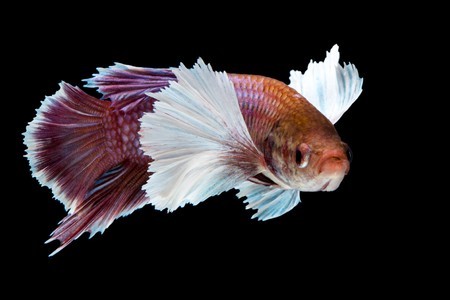
(Elephant Ear Betta, male)
So you’re considering a betta?

(Male veil tail betta, female betta)
Betta tie with goldfish for being some of the most abused, misunderstood fish on the market. If you have a betta fish and reading this alarms you please don’t be too upset, in all likelihood you were given bad information or no information when you acquired one. I’m not here to pass judgment on you, but I am here to help you set things up so your fish leads a long and happy life!
The betta is an egglaying variety of fish but interestingly enough they do so with bubble nests. The male attempts to attract a female by blowing bubbles in a tight formation, usually in the corner of the tank. If your betta starts doing this it means he feels comfortable an safe!
They are from the gourami family of which there are over 133 recognized species!
Tank Size
It’s not uncommon to see a betta fish in a small tank or even vases and there are a huge variety of ‘tanks’ being sold that specifically claim to be for bettas. Betta should never, ever, ever, be housed in less than 2.5 gallons and even then I frown on something of that size, but it’s way more preferable to anything smaller. 3+ gallons are far better. Many of the ‘tanks’ that claim to be for betta are even less than 1 gallon! That’s the equivalent of your house being the size of a small closet. Sure you could live in that but it won't be pleasant at all.
Not only are they too small but many of them lack filtration or heaters and don’t even have the room for either! Betta require tropical temperatures, so between 75°-80° degrees Fahrenheit (23°-26° Celsius), like any fish they also require a filter (which also brings oxygen into the water).

There are good quality 3-5 gallon tanks that you can get and set up easily enough. I keep my betta in a 7.5 gallon planted tank. You can even just buy all the different parts you need to set up your own beautiful tank as 5-gallon basic tanks aren’t very expensive at all!
Some stores also sell ‘betta plants’ that they claim the fish will nibble on the roots for nutrition. Sure. A starving fish will nibble on anything to survive but they are primarily carnivorous. Not only are the plants starving the poor fish they also take up a lot of the surface area of the water, or even block it off completely! Betta are labyrinth fish meaning they can gulp air to get extra oxygen so it’s important that they have access to the surface of their water. Add to that that a tank filter isn’t just to clean the water of waste, but also to aerate the water to bring in more oxygen for your fish.
Types of betta:
Betta are being bred not only by hobbyists but professionals and over the years a bigger and bigger variety of them have become available. When I was just a kid, over 20 years ago, there were no varieties listed they’d just be ‘betta fish’.
Vieltail
The most basic variety are the ones I saw as a kid, they’re known as veil tails. This variety is so common that they aren’t even allowed to compete in betta shows (like dog shows but for betta fish!). Just because they are common doesn’t mean you shouldn’t get one! They’re still very beautiful and come in a variety of colors. They are called veiltail because their tail resembles a draping vail.
Combtail
Combtail betta can have any shaped tail or fins, but they also have extra extensions almost like fingers.
Crowntail
Crowntails are like the combtail on steroids. At least half their tail is made up with the trailing fingers, rather than just a short bit on the end.
Delta/Super Delta
These guys are rather stunning as their tails are symmetrical (if an ideal example) with the same amount of tail above and below and spread out evenly with no draping or drooping.
Double Tail
As it says on the tin. They don’t have a split tail but rather literally two tails! The two tails can be in different sizes.
Half-moon/Over- half-moon
These fellows have tails even bigger than the delta/super delta mentioned above, about 180 degrees and some even over that. That severe of a tail can lead to them being more easily damaged, try to avoid anything sharp or rough in their tank.
Halfsun
Sort of a mix between a combtail and a half-moon tailed variety with a dash of delta. They have full flowing tails with a bit of a fringe at the edge.
Plakat
For this variety, their tails are much shorter, but still fanned out and beautiful. Due to their short tails, they’re much less likely to be damaged.
Rosetail/Feathertail
These lovely boys are tails that are so full they look feathery!
Roundtail
Their tail is even fuller and round than the plakat a bit like a D shape.
Spadetail
Where the roundtail has a nicely rounded tail the tip of the spadetail’s fin comes to a little point!
Elephant Ear
With these, it’s less about the shape of the tail and rather the shape of the fins. They’re very big! The featured image of this post is of one!
Those are just the tail shapes, as to their color patterns? Here is a quick list of color types:
Butterfly, koi, Cambodian, marble, dragon (avoid this variety as they often get scales growing over their eyes), mask, multi-colored, piebald (like marbled but different!), solid, wild type (less vivid colors, closer to how they appear in the wild).
The colors they come in are across the spectrum, including albino. Finding the color, pattern and tail combo you like may be a challenge, but betta fish are easy to find and easy to take care of.
Recently a new variety has come to market known as ‘kings’ this just signifies them as being a super-sized betta! I have a half-moon wild type betta and he is easily twice the size of regular betta.
Good Tankmates
If you have a smaller tank, like a 3-5 gallon I suggest keeping your betta solo as they are very territorial! They can be housed with snails though, but make sure to introduce the betta to the tank first or he may kill anything that was in the tank before him to establish his territory.
Betta have wildly different personalities, one person will have a peaceful community friendly betta and another will have a ‘Kill all trespassers!’ variety. It needs to be stated that males and females don’t really get along very well. I also don’t suggest breeding them as they are already heavily bred professionally and by hobbyists. Only try breeding if you are very very serious about it and have the room for them.
I have successfully kept my king betta with other fish in a large tank that gives both him and the tankmates to move around in. As long as they have a buffer a betta shooould be willing to play nice. Be warned though, this may not be the same for you. I would also suggest avoiding putting them in a tank with another fish that has a big flowing tail.
Betta also move up and down the tank meaning, no territory is really safe from an aggressive betta. Cory catfish may work in a large tank, tetra may be quick enough to avoid an aggressive betta but keep a close eye on them to make sure he isn’t overly stressing them out. It’s a lot of trial and error.
Feeding
There are a lot of different foods you can feed to your betta but make sure to get food specially formulated for them. Also, try to mix up the variety of food you give them. Frozen small foods such as bloodworms, brine shrimp, krill and the like make good treats but not as a regular part of their diet.
Make sure to only give them a few pellets at a time, as their stomach is only about as big as their eyeball and they can be very greedy eaters and you can overfeed them! Yes, betta can get fat!
Tank Temperature
75°-80° degrees Fahrenheit (23°-26° Celsius)
Final Words
Betta are some of the best beginner fish as long as they’re given a good home. They’re full of personality, they live 3-5 years, are very hardy and easy to care for. They’re personally one of my favorite fish and I never tire of them!
If you want to find a rarer type of betta ask around online, speak to local aquarium clubs and you’ll definitely find a breeder who can help you out.
#betta#siamese fighting fish#betta fish#fishblr#aquarium keeping#freshwater aquarium#freshwater fish
33 notes
·
View notes
Text
Are you really getting what you pay for?
Petco, Petsmart, Pet Supplies Plus, Petland, and other chain shops are notorious for the amount of poorly cared for bettas that are sold for pretty cheap. You can get dragon scale bettas, halfmoons, plakats, rose petals and dumbos for less than the cost of a full tank of gas. Of course, there is a stigma associated with buying this mass produced bettas. They’re unhealthy, they feed a market that needs heavy regulation from consumers, and over all are treated in poor conditions, inhumane conditions.
We don’t feel good buying these bettas sometimes, but we love the animal, so we seek other options. We go onto aquabid or ebay and see gorgeous bettas, and expensive ones too. You can find some nice looking fish for about the4 same cost in the store, not counting the exorbitant fee for transhipping, or you can find some that seem outrageously expensive. But you get what you pay for, right? If you’re investing so much into a fish, you’re going to be getting a healthier fish than the ones you’d find in the store, isn’t that right?
Not necessarily.
Now I need to preface this by saying I do like bettas, they are charming fish with a lot of personality that are also incredibly accessible and relatively affordable to care for. I have four bettas of my own, they’re important to me, but I acknowledge the pitfalls that come with the domestic betta we all drool over. I am speaking from my own examples, as well as the many collected examples I can recall from the three or so years I’ve been around fishblr and seen the rise and fall of everyone’s bettas.
The goal of this isn’t to call anyone out. The goal of this is for you, the consumer, to be aware of where you might wanna be spending a lot of money, and what you’re ultimately getting in return. I do feel like it is predatory for a seller to market a fish they know is unhealthy, critically inbred and overpriced without much remorse. I do feel that the onus is on the seller and the breeders for pushing these fish that look stunning but are genetic train wrecks that will die within two or three years, especially when you may be spending well over a hundred dollars on a fish in the end. The sellers know this, they are well aware of how unhealthy a betta is, but are more than willing to hype up a fish and charge the consumer a ridiculous price for a fish that is no different than a fish bought from Petco. I am using Glee Bettas, the breeder that Space City Fish uses for the bettas they sell, as the example for this post specifically because Space City Fish markets to tumblr heavily and they know that fishblr is into bettas. They target fishblr specifically because bettas are the most popular fish here.
I’d like to start with a fish we know a lot about, the dragon scale betta. What is a dragon scale betta though, other than a betta with pretty, metallic or opalescent scales? Dragon scale bettas are bettas who have essentially had the genes that go into making metallic scales turned on into overdrive. All bettas have the potential to develop iridescent or metallic looking tissues and scales, it comes right from the wild betta splendens.
youtube
As you can see, the betta above has very light hints of metallic iridescence to it.

These bettas, all from Glee Bettas and all used by Space City Fish as the transhipper/proxy seller, are extreme forms of dragon scale bettas who are “full mask”, meaning their scales are thickened all the way to their face, and in the last one, are starting to over take the fish’s eyes, rendering them blind. A betta that is already blind is being sold to the consumer for a luxury price. An already unhealthy fish is being sold to you for more than what you’d pay for a fish from Petco.
Aside from being blind, dragon scales are notorious for developing tumors. Why does this happen? It is most likely because the proteins that are supposed to tell the other proteins to stop producing so much tissue simply don’t exist or are so low in number that the tissue simply continues to grow. Without an ‘on/off’ switch for this gene, it simply keeps happening. We simply wouldn’t have a dragon scale betta unless they were bred for this trait, a trait that ultimately kills the fish or decreases their quality of life drastically.
I had a dragon scale girl I bought from an LFS who imported bettas, Zelda. Zelda started developing a tumor near her pectoral fin and I was concerned, but figured it wouldn’t effect her. About a month later, she began forming another tumor behind her gill, which was getting large enough to start pushing her gill into a permanently open position. Soon, I noticed one side of her body bulged more than the other and figured she had internal tumors developing too. I had her for six months before her organs failed and she exhibited some of the worst dropsy I ever saw in a betta and ultimately euthanized her.

Let’s start off with koi bettas next, which will be relatively short. Kois are simply marble plakats sold to you under deceptive pricing. The koi sold to you is young, under 6 months, and hasn’t had any changes to its coloring yet. Above is a young koi female who has yet to undergo any color change.
Here’s Tony when I first got him.

Here’s Tony now.

Totally different fish, right? Nope! Same exact betta, he simply lost all of his unique coloring and it all blended into one ugly mass of blacks, blues and red. All the yellow vanished.
He’s bright, he’s perky, but would you pay $20 for him now? How about $30? Or $40? $50? Because you’re ultimately paying a luxury fee for a betta that looks how it does in photos as a 3 month old and will never look like that again for the rest of its life.


And do I really need to mention the struggles bettas with huge fins have? We’re all aware of what fin biting is, an unnatural behavior that bettas exhibit when they are stressed and unable to move the way they think they should. Go back to that wild betta video and see how small those fins are. Bettas are ambush micropredators, they are capable of immense bursts of speed very suddenly. A domestic betta hasn’t lost that drive to move in that manner, the bettas above are just as likely to want to move in quick bursts of speed as a smaller finned betta, but they can’t. They don’t understand why their bettas are weighed down by these incredible amounts of finnage. The rays to their fins may be broken, they may have torn tissue, and they fall to fin rot because of the torn tissue that’s exposed to bacteria found in their water. Or they bite. They bite off their fins because it’s the only way to lessen the amount of fins they have so that they can move.
This behavior should be held in the same regard as feather plucking in parrots. No animal willingly harms itself without encountering incredible stress from either its environment or something affecting their way of life. A betta with heavy fins that ultimately will fin bite should not be regarded with awe or the need to buy it, but be seen as an animal that is unable to preform the natural behaviors a betta is wired to do.
Again, you’ll be spending a lot of money on a fish that can’t do what it wants to do, which is move around and be a fish.
We all know that bettas are unhealthy, pet store bettas are as sickly as bettas bred by Thai importers. There is no difference between these bettas but their price tags.
What you do with your money is ultimately up to you, however if you feel the need to buy a betta, there is little difference between going out and getting one from a chain store than from a seller like Space City Fish.
428 notes
·
View notes
Text

Common name: Siamese fighting fish
Scientific name: Betta splendens
Average life span: 3-5 years
Diet: pellets, daphnia, brine shrimp
Bio: This is ignis he is my own betta fish and He is a koi marble plakat!
Male betta's come in a variety of different colours and shapes and will fight if housed with another Male!
Female bettas are smaller in size and in most cases not as colourful!
When looking to mate the male betta will create a bubble nest to house the eggs of his partner, picking them up in his mouth and spitting them inside a bubble!

3 notes
·
View notes
Photo



yo fishblr, i need some input - what the heck is going on with my betta?
i just noticed this this morning when i went to feed him; there’s a white patch on his head and two little white dots on both eyes (i normally feed them after i come home from work so the lights are off, so this popped up sometime in the last 3-4 days). he’s still super active and hungry as usual, and i tested the water and it came back fine (0/0/10-15, 79-80f). he’s in a filtered, planted 10g all by himself aside from a nerite snail.
he was a mostly-white koi when i got him, so i’m not sure if the white is marbling? and if the dots are just cataracts or smth... the fact that they’re symmetrical is weird and makes me think it’s something systemic as opposed to like a fungus or whatever. or if it is something else, what do? i have kanaplex but that’s the only med i have atm..
@gar-a-ash ? or anyones input please. thank you!!
32 notes
·
View notes
Note
Hello, can you help me? My betta started to get some gray/white scales under him, he used to be a very dark red, I'm worried...
Hi there anon! :)
It’s very common for bettas to change colors, and usually bettas with a “marble gene” will do this. I see it happen a lot with white and blue bettas and bettas sold as ‘koi’ bettas :3
If you could reblog with some before and after pics, or send me a message with some before and after pics, I could let you know if that’s what’s going on, or if something else may be causing this change :3
1 note
·
View note